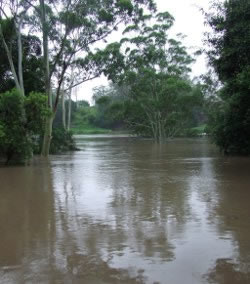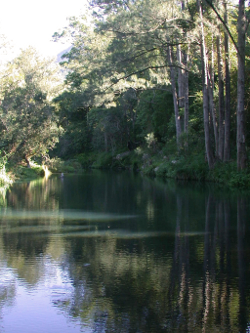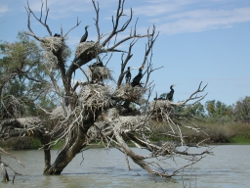|
|
Riparian vegetationVegetation is in an important component and driver of wetland systems. Through the process of photosynthesis plants convert energy from the sun into a form that provides the basis for aquatic and riparian food webs. The photosynthetic process also oxygenates the sediment and water column, which is particularly important in the aquatic environment and essential for the health of many other wetland creatures. Vegetation also influences the microclimate of the wetland as it can provide shading. Logs and other vegetative debris contribute to habitat complexity and influence water flow and channel formation. The baffling effects of vegetation (both living and dead) slow water and encourage deposition of sediment particles, influencing water quality and clarity. Quick facts
ShadeDepending on the composition of the riparian zone it may provide ample shade for the water, reducing the amount of light and heat reaching a stream. For some provinces (e.g. Murray-Darling and Central), the sparse vegetation in the riparian zone does not give much shade. In other systems the reduction in light results in a reduction in the abundance and possibly species richness of algae and macrophytes that may otherwise be present, ultimately decreasing in-stream primary production as well as water temperature. These shading effects are more influential in the upper reaches of a stream system where the stream channel is narrow. The effect of shade on temperature in large, wide channels may be negligible. Fish utilise shade as an area of cover from which to launch predatory attacks, as well as a refuge from predation[10].Pusey and Arthington (2003)[2] suggest that increased rates of transfer of thermal energy between the atmosphere and stream in the absence of an intact riparian zone may disrupt reproduction of fish, and have direct effects on mortality rates, body morphology, disease resistance and metabolic rates in fish. Riparian vegetation influences the spectral qualities of light entering the stream[10]. Changes in light quality can lead to increased mortality of fish eggs and larvae due to increased ultraviolet light irradiation, reduction in the ability of adult fish to discriminate between potential mates, and increased conspicuousness to predators[10]. Nutrient and debris inputsBoth direct and indirect inputs are provided to the stream by riparian vegetation. Depending on the type of riparian vegetation it may deposit fruits, leaves, bark, large woody debris and/or snags into the stream. These inputs supply nutrients to the stream food chain. Terrestrially derived matter is consumed directly by some fish[10] and macroinvertebrates, and may be an important source of energy to some systems. It should be noted that in some systems (e.g. those dominated by grasses) the riparian zone may not provide many nutrients to the water. When leaves derived from riparian vegetation first enter a stream, the soluble components undergo leaching. Fungi and bacteria then condition the leaf material, before macroinvertebrate shredders consume fragments of the leaves. The seasonality of leaf inputs, the volume, and the chemical composition of the leaves are determined by the species that occur in the riparian zone. Native vegetation, such as species of Eucalyptus, Acacia, and Melaleuca, have sclerophyllous leaves, which may persist for months or years before completely breaking down. Herbaceous material, such as grass litter, breaks down very quickly in streams. A sclerophyllous input ensures a continuous food resource for stream organisms, whereas herbaceous inputs may not be as consistent throughout the year[11]. Riparian zones dominated by exotic vegetation such as the willow (Salix sp.) supply an autumn-dominated energy input to the adjacent stream, providing only a brief food supply for aquatic organisms[4]. Litter fall in Australian forests tends to be continuous throughout the year, with a peak in summer[6][7][3]. Some streams in Queensland are fringed by the exotic camphor laurel (Cinnamomum camphora), the leaves of which contain camphor, camphorene, and reticuline, which may be unpalatable to stream consumers[5]. As a result, these leaves take a significant period of time to break down[11]. Debris from riparian vegetation provides habitat for stream organisms, e.g. the caddis fly larvae (Calamoceratidae) binds pieces of leaf material together to produce a mobile home. Some Leptoceridae, another type of caddis fly larvae, utilise hollowed-out sticks derived from riparian vegetation. Leaves, bark, large woody debris and snags also provide cover for fish and macroinvertebrates, and are a substrate for diatom and algal attachment. Riparian vegetation influences the interception, storage and release of terrestrial nutrients. The riparian zone acts like a 'filter', reducing the amount of nutrients and suspended sediments carried in run-off destined for the stream. Additionally, riparian zones can minimise flood peaks following heavy rainfall[1]. Micro-biological processes, such as denitrification, occur in the riparian zone. HabitatVegetation in the riparian zone, such as grasses, can provide spawning habitat for fish when inundated. The velocity of flood water can be slowed by large woody debris and trees forming eddies and backwaters, which may also provide favourable spawning sites for fish that are cued to spawn during high flows.Vegetation provides habitat for terrestrial insects, which indirectly results in inputs to the stream when these insects drop from overhanging vegetation into the water and become food for other invertebrates, fish and turtles. Some of these insects may have originated from the stream. Many insects encountered in a stream are larval or immature, and they eventually emerge from the water as winged adults. The riparian zone provides a corridor for the movement and dispersal of these winged adult insects. The distributional patterns of riparian flying insects are influenced by the density of riparian vegetation, and can vary with height, distance from the stream, and season. Riparian vegetation provides nesting sites for waterbirds. Flooded lignum (Muehlenbeckia florulenta), for example, is an important nesting habitat for waterbirds including colonial waterbirds and the freckled duck[13]. Bank stabilisationRiparian vegetation also serves the function of bank stabilisation, reducing erosion. The roots of riparian plants bind the stream bank and help to reduce slumping, allowing the bank to become undercut without collapsing[1]. These under-cut areas are habitat for fish and macroinvertebrates, and exposed tree roots may be used as a spawning substrate for fish[9]. Woody debris and snagsLarge woody debris (LWD) refers to whole trees, logs, branches and sticks that have fallen into rivers and streams. Snags are large complex accumulations of LWD. Once fallen into rivers evidence from elsewhere indicates LWD can persist for hundreds or even up to thousands of years[8]. LWD provides habitat for many aquatic organisms[12]. It provides a hard substrate for the colonisation of many species of bacteria, fungi and algae which form complex encrusting biofilms, essential components of carbon and nutrient pathways in aquatic systems. It is an important habitat for aquatic invertebrates and typically supports specific assemblages different from the fauna of other habitat types. Some species use the wood as a hard attachment site to filter feed, but most species feed upon the encrusting biofilms or occasionally the wood itself. Some macroinvertebrate species also use LWD as a hard substrate on which to attach eggs. LWD is also a major habitat for many species of fish and is the major habitat in rivers with low substrate heterogeneity and without other forms of complex habitat structure. Fish utilise LWD and snags to avoid predators, shelter from direct sunlight, avoid high water velocities, as ambush sites used by predators to capture their prey, as territorial markers, as spawning sites for adhering eggs and as both adult and juvenile habitat. Snags also provide habitat for birds, turtles, frogs and aquatic mammals. In sand or silt dominated rivers, LWD can provide the only stable substrate for biota, particularly during periods of high velocity flows. In intermittently flowing rivers LWD can act as a drought refuge permitting the persistence of some species during dry spells. References
Last updated: 22 March 2013 This page should be cited as: Department of Environment, Science and Innovation, Queensland (2013) Riparian vegetation, WetlandInfo website, accessed 8 May 2025. Available at: https://wetlandinfo.des.qld.gov.au/wetlands/ecology/components/biota/flora/flora-structural/riparian-vegetation.html |

 — Department of the Environment, Tourism, Science and Innovation
— Department of the Environment, Tourism, Science and Innovation





